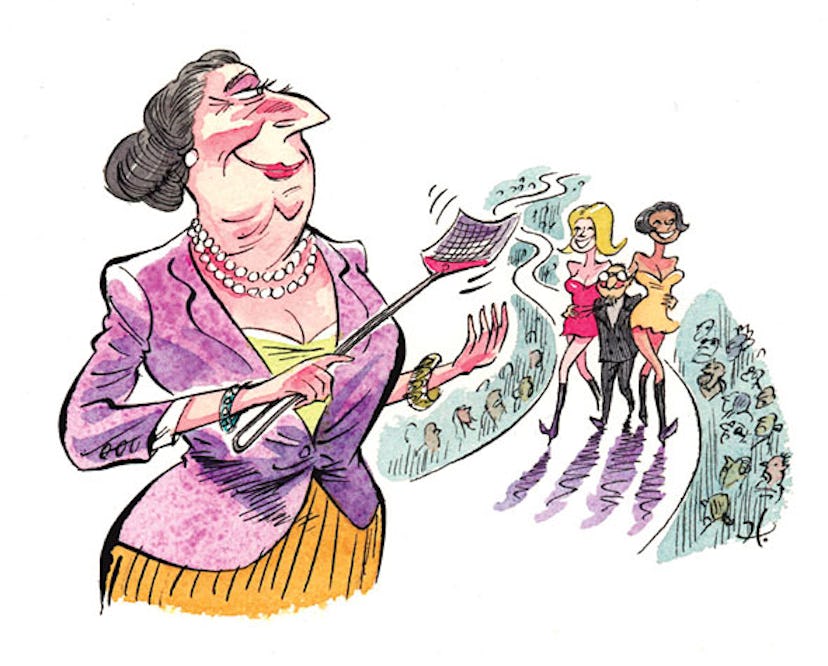Countess Manners

What is the excuse for today’s fashion rudeness and fashion madness? None!
To quote William of Wykeham, “Manners maketh man” (or, in this case, woman too). As my dear mama always scolded me, “Liebchen, it is manners that matter—only manners.” She wasn’t talking just about saying please and thank you. There is a code of behavior that distinguishes a gentleman or a lady from the boors. One behaves that way at all times, not just when someone else is watching.
So let’s be positive first: There are designers who have good manners and who only occasionally misbehave. (After all, this is the fashion world, which is maddening enough to drive even the most saintly person over the edge at times.) I am thinking of Karl Lagerfeld, the high-living Valentino, Yves Saint Laurent (not his partner), John Galliano (most of the time), Oscar de la Renta, Ralph Lauren, Alber Elbaz, Alexander McQueen (usually), Marc Bohan, Donna Karan, Emanuel Ungaro, Miuccia Prada, Dries Van Noten, Raf Simons, Stefano Pilati, Christopher Bailey, Nicolas Ghesquière, Carolina Herrera, Diane von Furstenberg, Bryan Bradley (there’s a difference between being outspoken and exhibiting bad manners), Stella McCartney, Michael Kors and Donatella Versace.
Ironically, the women tend to be less bitchy than the men, though it’s all relative. Take Coco Chanel, who never had a bad word to say about anyone—in public. In private, it was another story. She didn’t have one nice thing to say about any of her peers then, especially Saint Laurent and Cristóbal Balenciaga. She would slap her sides and say they didn’t know how to cut a skirt or pants and that they didn’t understand a woman’s body.
Balenciaga, while well mannered, wasn’t into dishing about anyone else; he was too wrapped up in his monastic studio and a very few high-society ladies. Christian Dior was the same way, but his focus was more on foie gras than fashion gossip. Meanwhile, across the street, Balenciaga’s good friend Hubert de Givenchy was the perfect gentleman—so they say—but his charm was reserved for the right people, like Deeda Blair and Mercedes Bass. Le Grand Hubert once planned a dinner for Jayne Wrightsman at Versailles’s Petit Trianon, but she canceled at the last minute. As for the press, I recall the time he tried to slap an editor in the face because we were five minutes late after visiting Saint Laurent. Only through my sheer bravery was the journalist saved the pain and embarrassment of le slap!
There are others who scream, rant, throw things, cry, whine. It’s a miracle they produce collections—or get anyone to work for them. In fact, some designers even have their own minders to make sure they behave.
Consider the youngish designer in the news lately for sticking his tongue out at the end of the runway—let’s hope, as my mama always warned me, that it doesn’t stay stuck out. It’s rude, as is keeping the working press and even your backer waiting for more than an hour for your show. Designers are making clothes. They’re not making history or art, even though they think they are, and they shouldn’t be so self-important about it. Another designer in the same stable, who usually is well behaved, once stood up the Queen. His minders claimed he was ill—although no one bothered to let Buckingham Palace know.
But those antics can be par for the course. Like the French designer who wrote to me to complain that one of my colleagues had the taste of a concierge (to be fair, at least the designer didn’t say it in public). Or Pierre Cardin, who, when he saw a writer who had given him a bad review, would cross the street to avoid him. Or the designer who sent dead flowers to a journalist who wrote an unflattering review of his collection.
Let’s be truthful: Fashion designers hate the press. Of course, some of the press deserve it. They can be oafs, basing their opinions on whims and whether they’re invited to the best parties. Diana Vreeland and Carmel Snow were ladies of a certain charm that doesn’t exist today, except perhaps in Suzy Menkes and a few others.
In the end, though, do manners really matter in today’s cutthroat, multibillion-dollar, celebrity-driven fashion world? Can a designer get to the top of the heap without having a go-for-the-jugular instinct? Maybe it’s me who’s out of fashion. To which my dear niece would say, shrugging, “Whatever.”
Gary Hovland